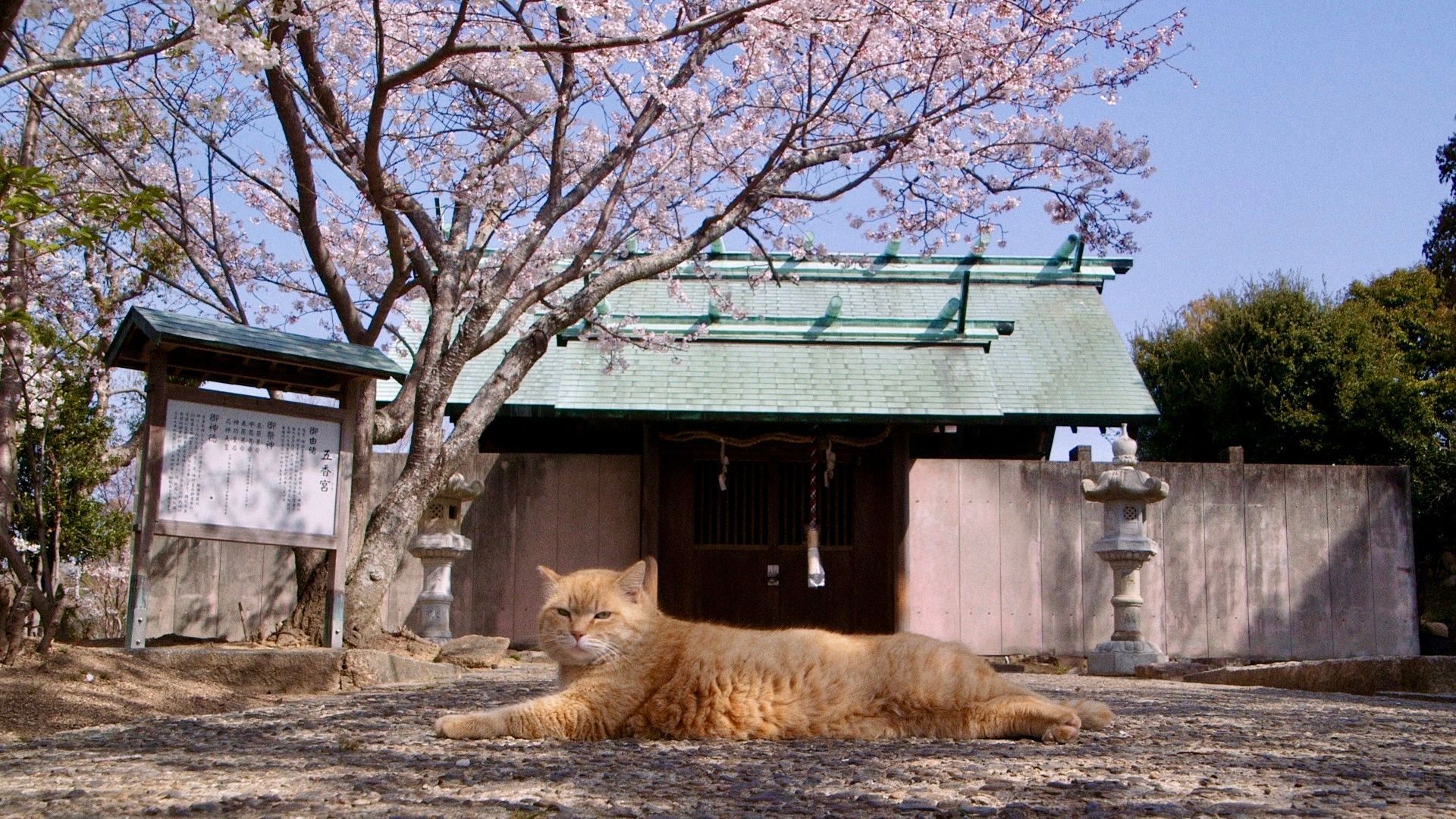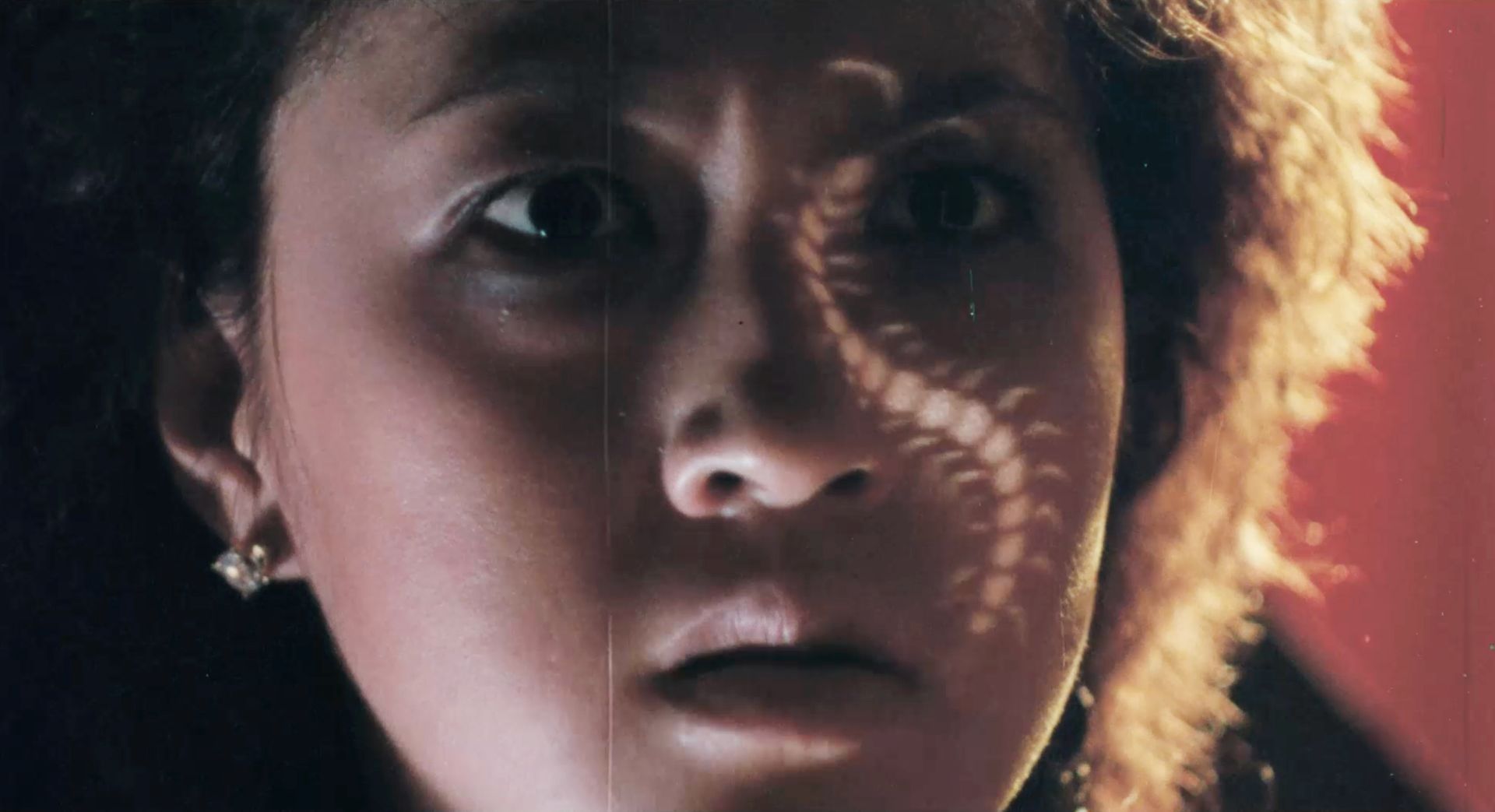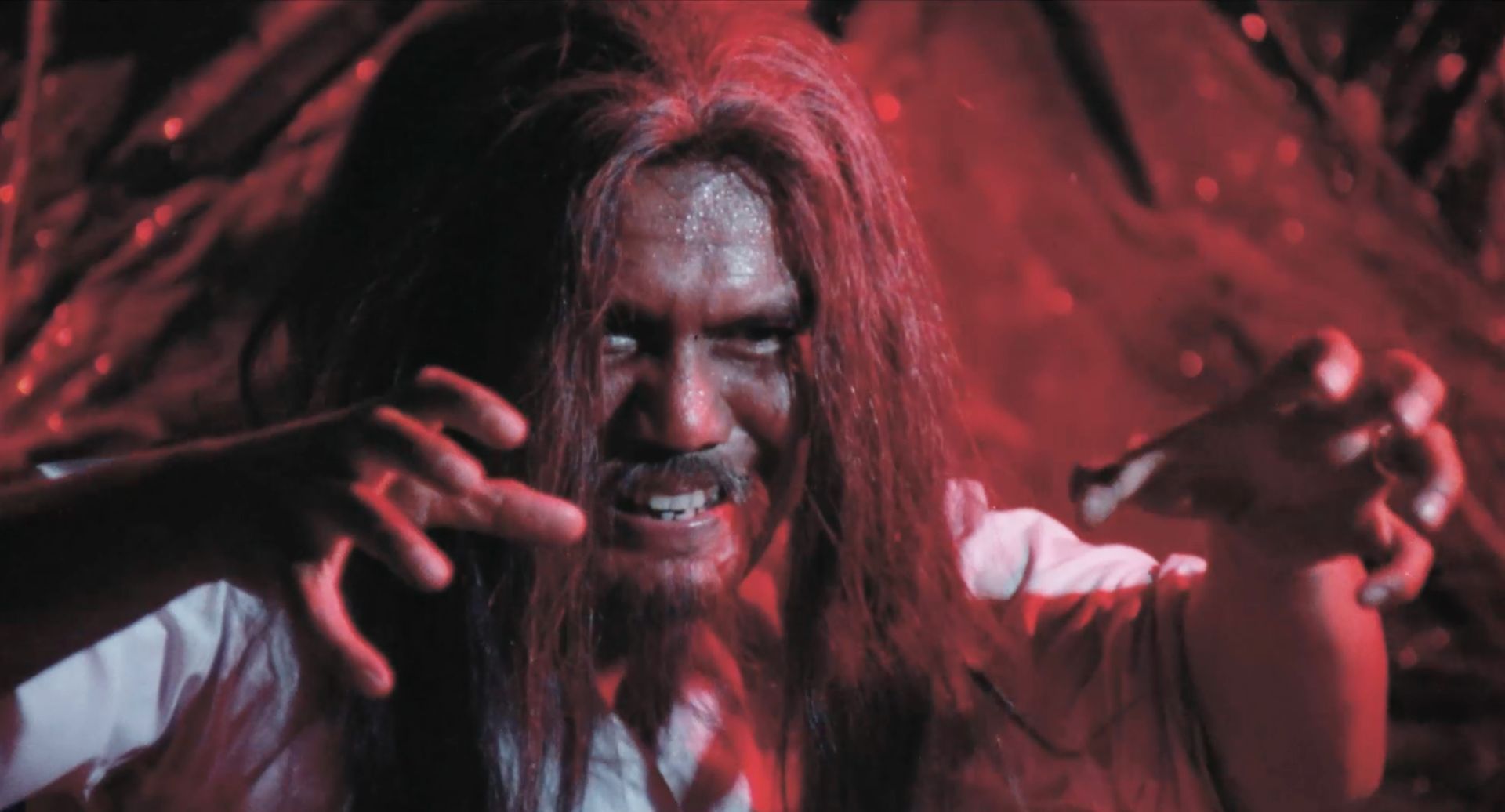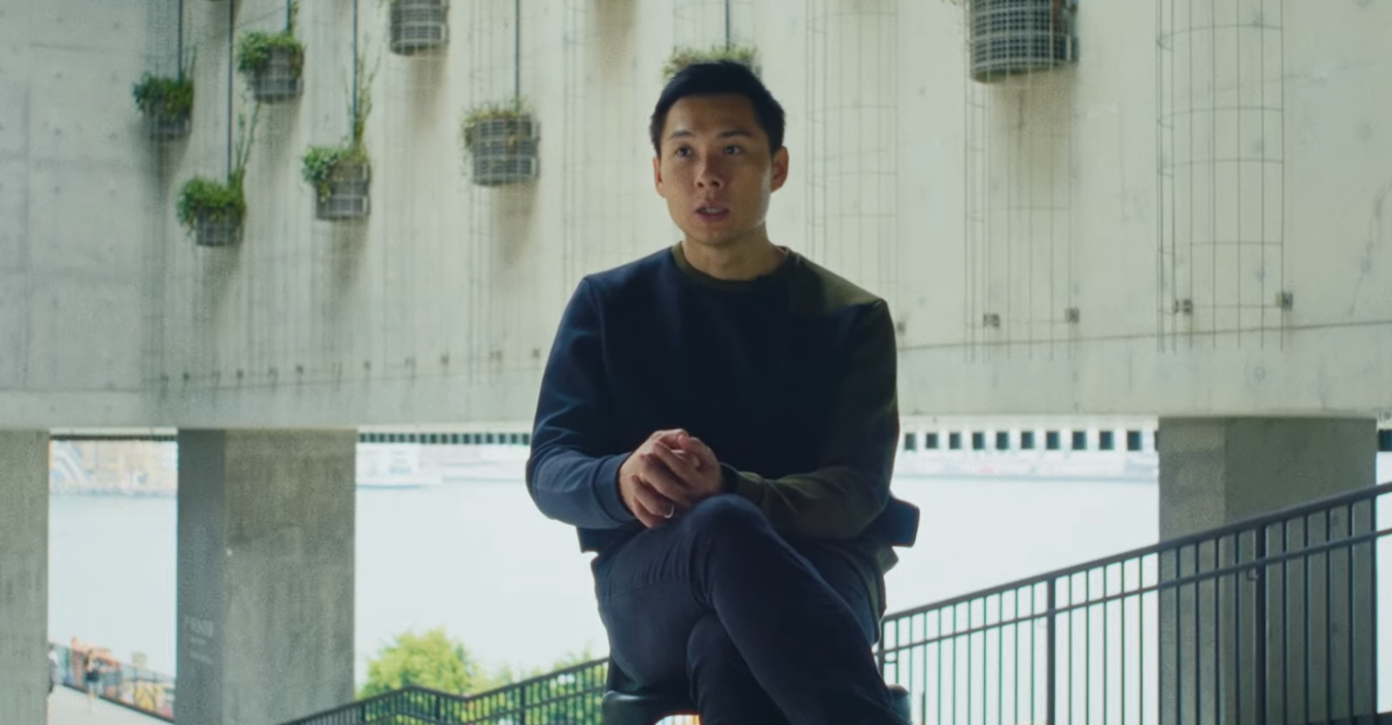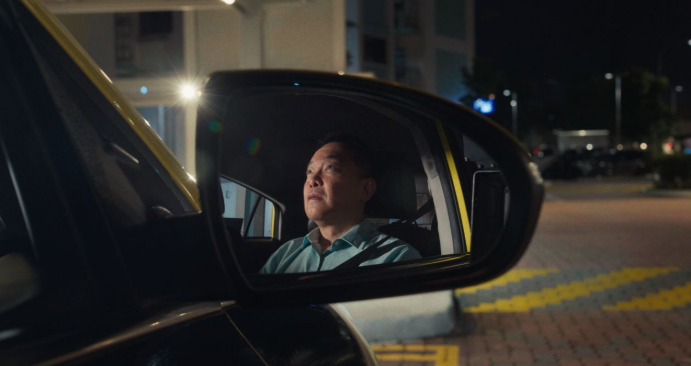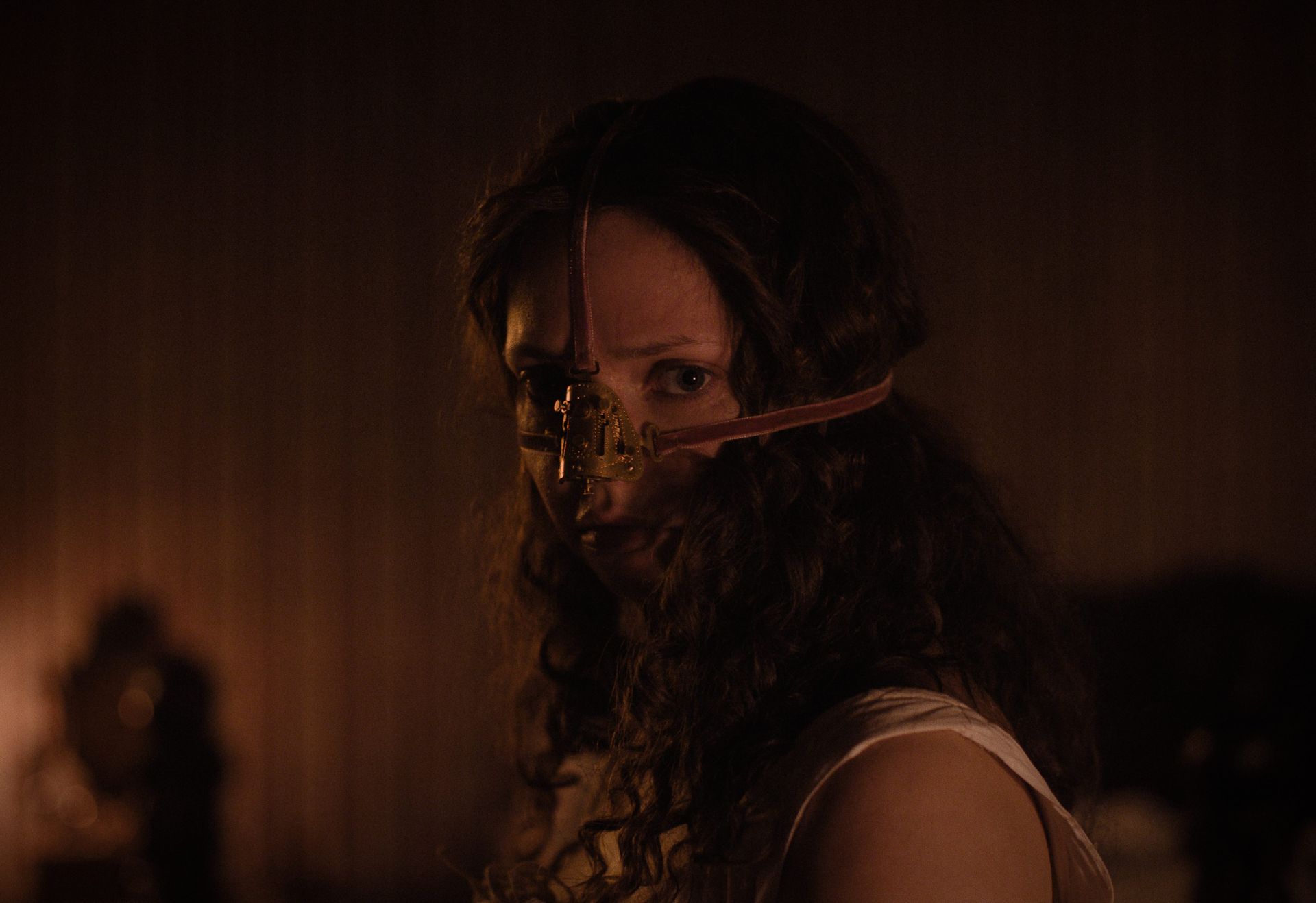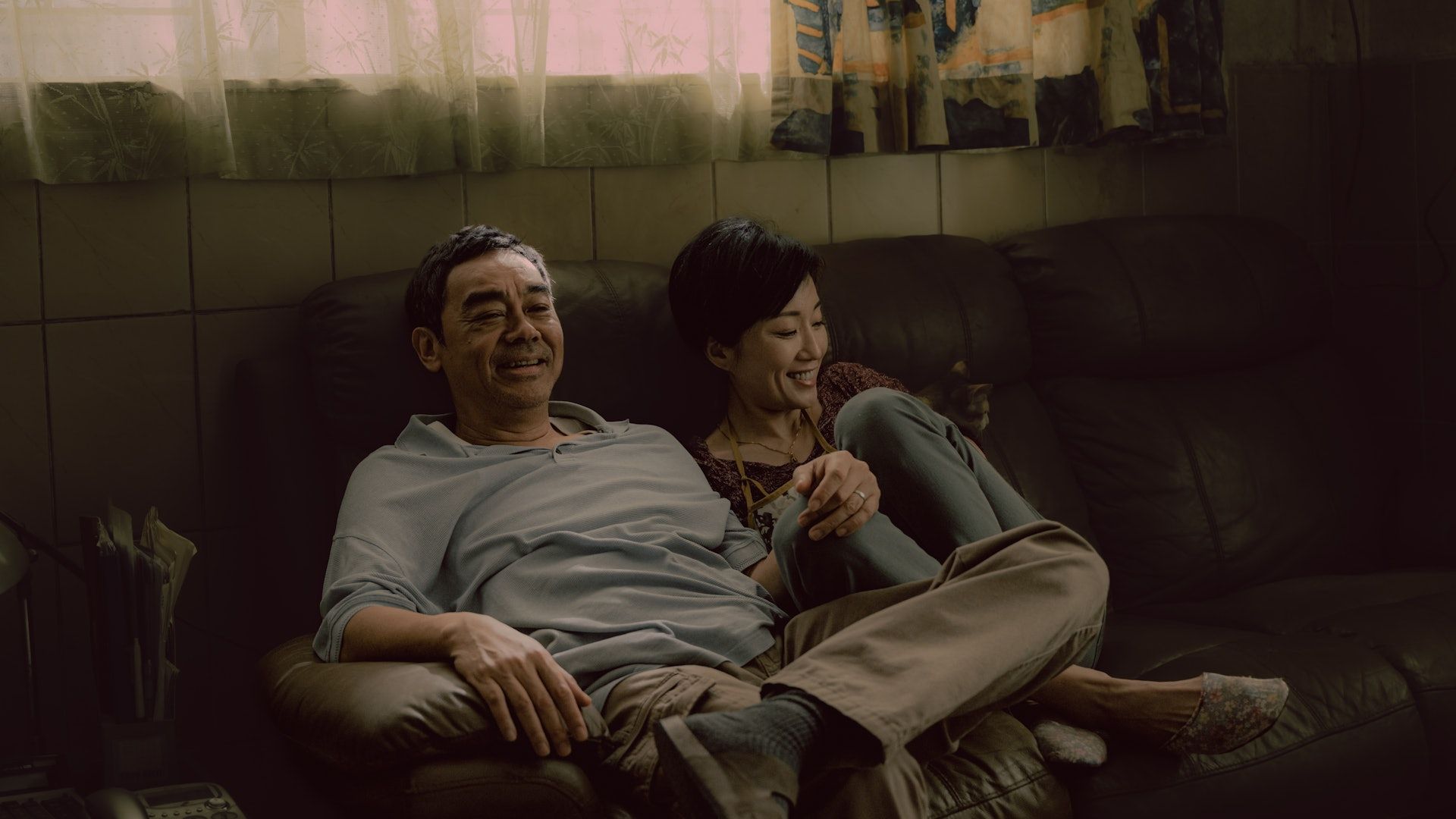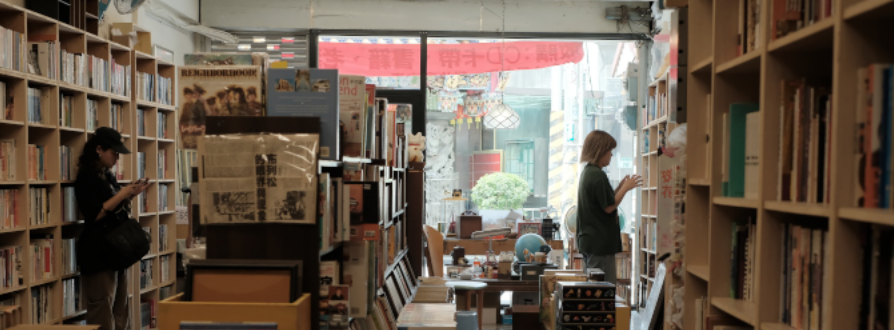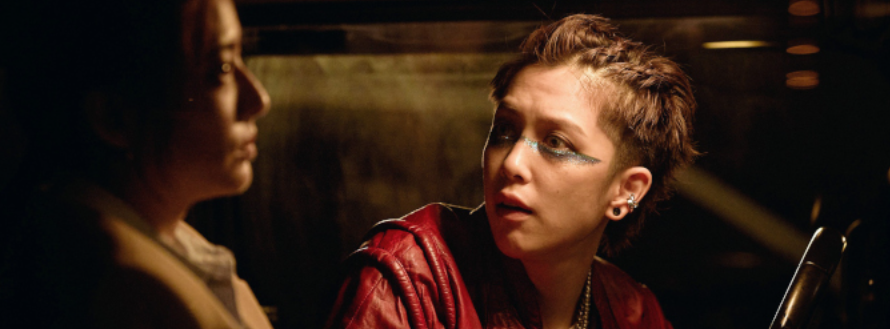Singapore in NDP MVs Through The Years, A Panel Summary
Singapore in NDP MVs Through The Years, A Panel Summary

In Singapore, our yearly National Day Parade (NDP) Music Videos (MV) are arguably a national icon and a genre in itself. On 14 August, Singapore Film Society (SFS) set out to get behind the scenes by bringing together 5 NDP MV directors in a panel that explored NDP Music Videos through the years. Featured on the panel were: Huang Jun Xiang (2021, 2016), Jerrold Chong (2021), He Shuming (2020), Li Lin Wee (2018) and Gloria Chee (2005, 2006, 2008), with the discussion moderated by Dr Liew Kai Khiun, a scholar of Transnational Popular Media and Cultural Studies in Asia.
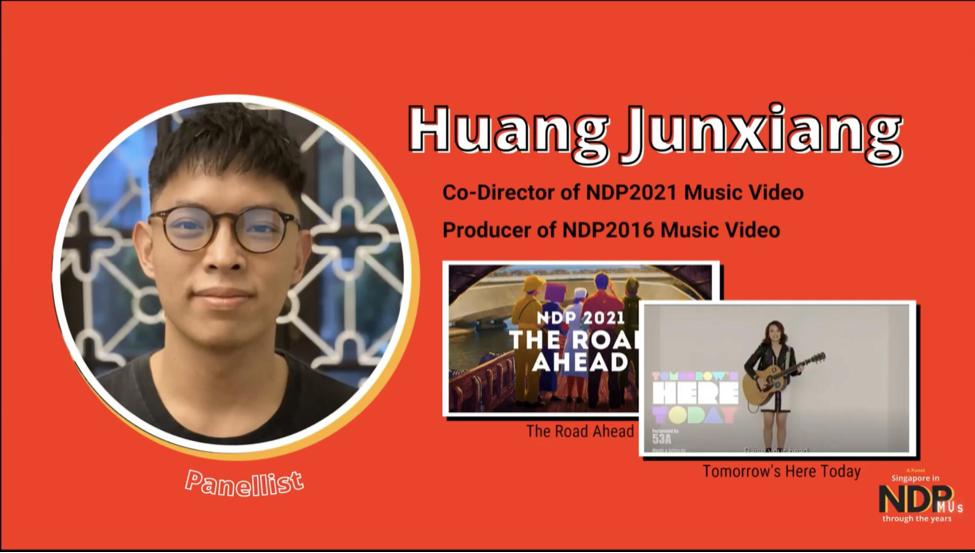

2021’s NDP MV was the first time ever that animation was featured heavily! Jun Xiang and Jerrold shared about the unique creative process behind mixed media, especially when challenged to meaningfully integrate animation with live action. A difficulty they faced was capturing the tonal shifts in singers despite the consistent chorus, for example the upbeat Shye versus the contemplative Shabir. This was resolved by the use of shifting animation styles, with line drawings that became more defined at the end to accompany the musical progression. Another key concern was capturing the perennially elusive Singapore Spirit, which they approached with a novel lens. Drawing on the sense of fantasy offered by animation, they focused on the idea of perspectives, capturing projections of the future on “The Road Ahead” through windows of daily commute. The moving camera style of filming also added on a challenge for the animators because of the speedy perspective shifts. However, the style successfully conveyed the idea of cycles and movement with the rotation shot, embodying the forward-looking spirit of the song. The directors expressed surprise at the many people who commented or texted them privately, grateful to see bits of themselves in the MV - from the cyclists to the love of otters.

For Shuming’s MV in 2020, the challenges were of shooting during a pandemic, back when COVID-19 first became a defining moment in our national history. Reflecting on this, Shuming said that the “meaning of the song remains the same but takes on a new perspective”, which he noted was much more intimate from the usual rousing songs of the past. He discussed his ideation process, which included meeting with Dr Sydney Tan (music director of NDP 2019 and producer of the song) to understand how to make images that complemented and put meaning to the words. Trying to incorporate our new reality of constant Zoom calls without making it too on the nose, he decided to have Nathan Hartono sing directly to the camera, using the tight shot of him to “hook you in to the song”. He described the process of shooting during circuit breaker as a “surreal experience”. With the process constantly changing, Shuming recounted how they had to keep their crew “very small” and “eat in our vans”. In particular, the final rooftop scene got them “on Hardware Zone” within “10 minutes”, and they had “at least 10 visits from the police”, though the sets were kept within regulations and no further trouble came from each visit. He shared that despite the difficulties, one touching moment that stood out was when a family reunited on set after not seeing each other throughout the circuit breaker.
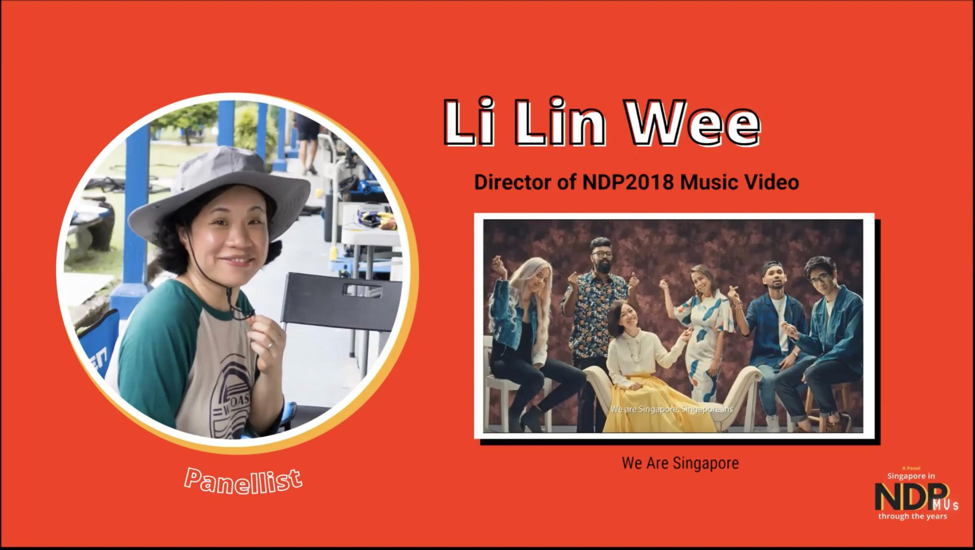
We then moved to nostalgic pre-COVID times in 2018, which Dr Liew jokingly described as “a time where social distancing was unheard of and having a crowd doesn’t bring in a police investigation”. Filming a rendition of the 1987 NDP song, Li Lin’s main concern was balancing something “very nationalistic” with making it “authentic for myself”. She shared how she turned to her passion for street and portrait photography, which not only gave her a lot of joy but kept her connected to Singapore and Singaporeans from all walks of life. Sharing samples of her work, she recounted how the medium was especially freeing as working as a director and teacher meant having to interface with a lot of people, while photography gave her the space to contemplate privately. Hence, she incorporated her love of portraits as a jumping off point for the MV story— Singaporeans having a very significant moment of their life captured in a studio or a location.
She gave us a peek into her ideation process, with test shots and the music videos that inspired her, namely Madonna’s American Pie and a TV commercial for Mercedes Benz. She was drawn to the way the video featured ordinary people from all walks of life, which lent them an authenticity narratively and emotionally. Inspired by the use of the flag in Madonna’s video, Li Lin wanted to incorporate our Singapore flag and its colours into the video in “a strong but not in your face way”. This resulted in different iterations like being embroidered or hanging in a school hall. To mellow out the fervent nationalism, she decided to ask the talents to pick what they wanted to wear in order to bring out their personalities while remaining comfortable. One of the most heartwarming things she shared was about the personal nature of the video to herself, where she cast real families, friends and colleagues. For example, she was not present at a former student's wedding, so she asked to “please bring the wedding to my NDP MV!”. The authentic emotional connections really shined through and she summed up the entire process of making the MV as a “lovely experience”.
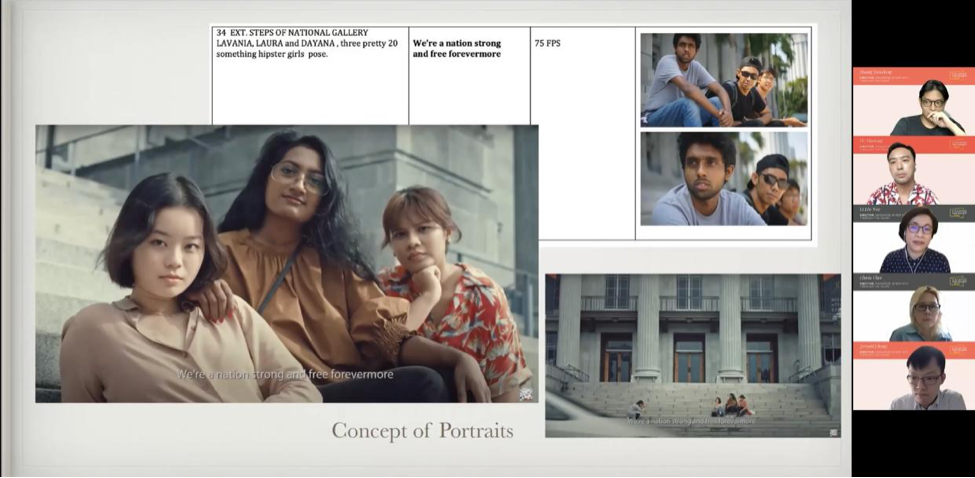
Asked about the process of dealing with creative directors and the NDP committee, Li Lin responded that it was “a really positive experience”. She shared a funny anecdote about presenting Madonna’s American Pie in a secret army bunker full of generals, and being pleasantly surprised when one broke the silence saying “I like it, I like Madonna”. She commented on their “astute notes” and encouragement, and the others echoed that the process, though expectedly staggered with back-and-forths, was hearteningly positive and inspiring. Jun Xiang added that he would “love to see a TikTok NDP music video”, noting that they are “creating a new language” to which Dr Liew pointed out the organic dance created by tiktokers (https://vt.tiktok.com/ZSJE6RL2L/) in response to the 2021 MV.
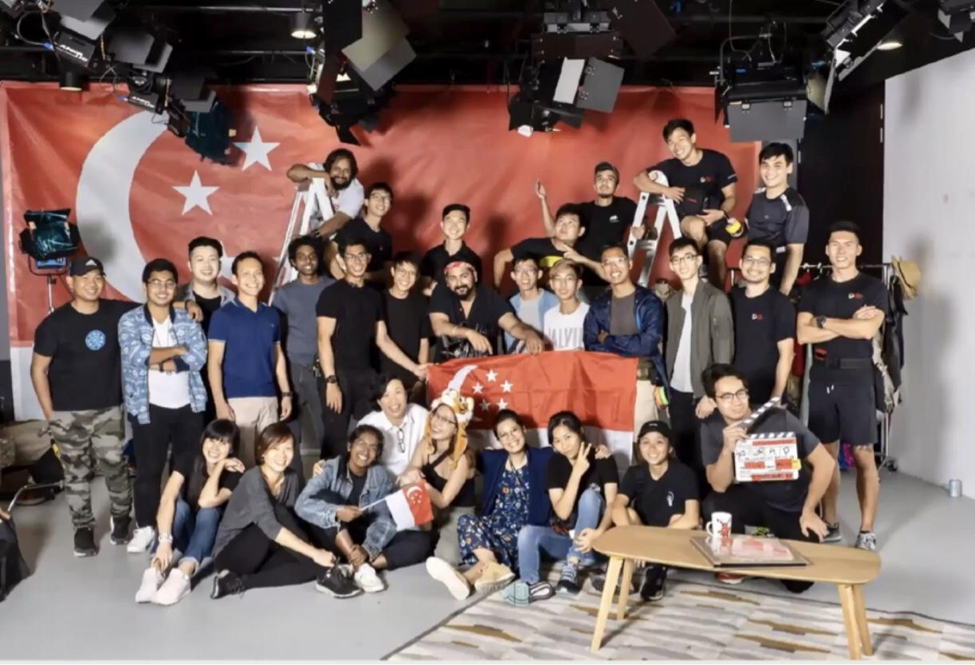
Jun Xiang was also involved in production for 2016’s MV, where he was only 27 at the time! The video was uniquely made with green screen and a massive cast of 400 people. He focused on the need for new technical concepts to bring across a freshness, like the video’s one-take shot. Even with content constraints, he remarked that there were a lot of resources that the army could mobilise for NDP directors. Recounting, he said that “Of the 400 probably 200 are army boys and the other 200 are their mothers, their friends or their girlfriends who were forced to come”, wryly adding that “hey everybody gets a free army lunch”.
Jun Xiang emphasised that these videos were ”creating a new visual history for the country in terms of what they can see and what they are exposed to”, paving the way for more courageous and adventurous explorations of form and content. Considering public accessibility to media content, he noted that while Netflix has a horrible way of monopolising what we see, the only thing that can compete is government ads due to the sheer amount of money they pour into it. He ended on a solid piece of advice: “whatever avenues Singapore content creators have they need to seize on it and do something engaging and fresh”, which is “important so that we still see Singaporean content as something of value”.
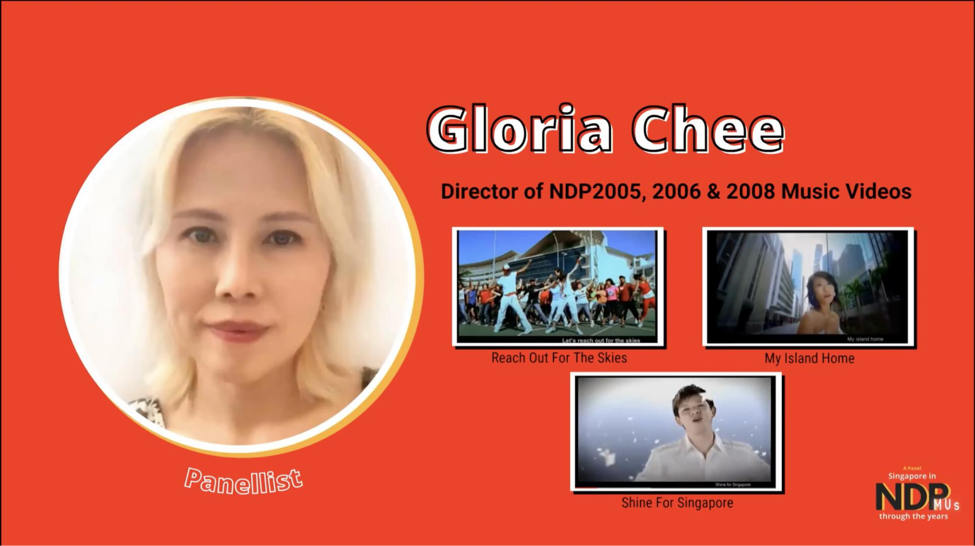
Ending the segment was the legendary Gloria Chee, director of some of Singapore’s most iconic NDP videos. Noting that “today I’m the classic”, she joked that the “main difficulty is in remembering” the process. A unique difficulty she faced was not having as many MVs to improve and learn from when she first started. However, things like the many different layers of buy-ins, multiple stakeholders and equal representation, she said, had not changed. She cracked a smile as she shared that she shot the MVs on tape, something she said reflected how old the videos were. Other experiences she enjoyed were getting different ages to learn the dance for 2005 and the old-school processes required to create graphics back then. On a personal note she shared how the process “hardened” her, as she was made to understand different and individual needs in a large scale project, translating big intent into individual shots. She was steadfast in declaring a need to be authentic, with every single frame being something not to regret. Dr Liew concluded her sharing by comparing Kaira Gong on the double decker bus in 2006 to the bus scene ending the 2021 music video, a beautiful link between past and present.
With the floor opened to Q&A, Jun Xiang drew a flurry of laughter when responding to a question on evolving audience expectations, recounting his friend’s comment likening the video to the “halftime-show of the Super Bowl”. He shared about the freedom of animation to insert easter eggs like turning the golden mile complex (which faces the sports hub) into a series of steps for the kallang wave. Despite stylistic differences between MVs over the years, he noted that each was a time capsule of each year, a slice of the times. On this note, Jerrold shared that something that stuck out to him was the thanks he got for including cyclists and otters. “After you put the otters in, people consider them Singaporean now” he quipped. He noted how they made the decision to invert the genders of the stereotypical male athlete and female dancer, commenting how the videos revealed a “maturing of (the Singaporean) vision over the years”. Gloria noted that in a generation with an advanced multimedia consumption appetite, it makes it harder to impress and yet the MVs are still capturing hearts.
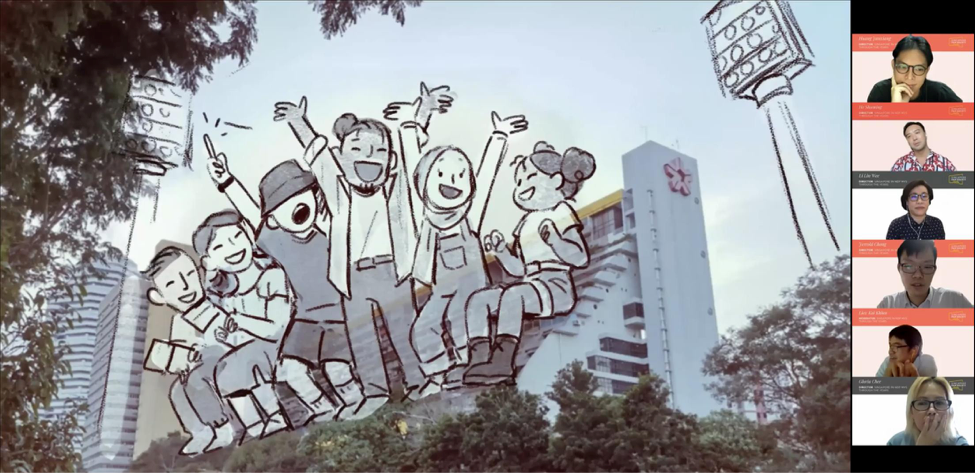
Dr Liew also commented on the way “everyday experiences are being validated” through the video, remarking on the progression from “simple CMIO” and “iconic landscapes” to the more personal and varied representations now, particularly the inclusion of disability in Li Lin’s video.
The session ended with early drawings and behind-the-scenes shown by Jerrold, giving a unique look at the concerns of animators and the visualisations required to pitch to the NDP committee. Everyone also shared hopes that this year’s ground-breaking movement toward animation would open up more national appreciation for the medium.
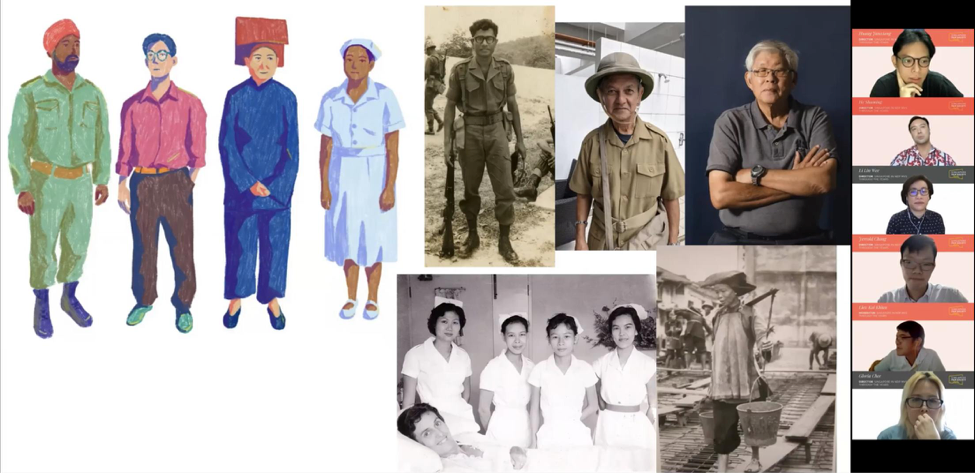

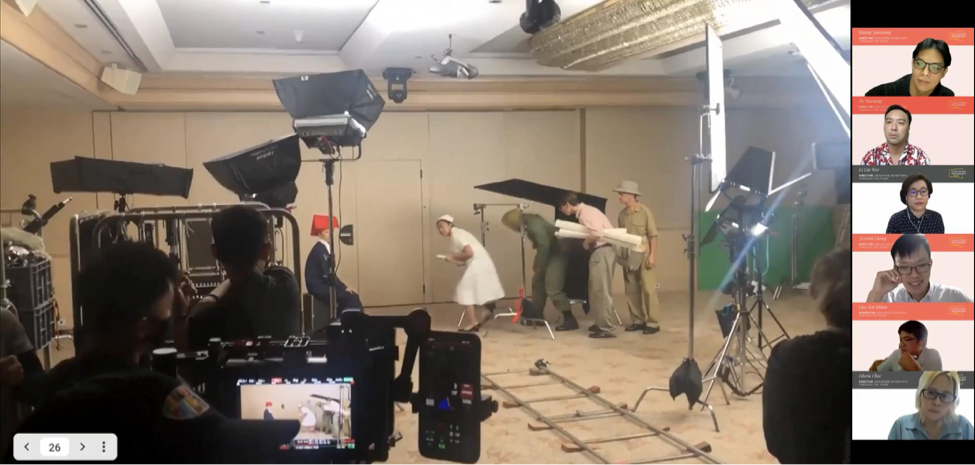
Ending on a note to future directors, Gloria shared the need for authenticity. “Dive deep in and have the courage to do it, even though it might seem daunting”, she says. Music Videos are a unique form of film and there is no denying that it has been a huge part of our connection to Singapore since young. Here’s to more panel sessions exploring this format!
Check out the full panel here: https://fb.watch/8129ga7X_t/
The NDP Music Video (MV) is arguably a national icon and a genre in itself. SFS set out to get behind the scenes on 14 August by bringing together 5 NDP MV directors in an inter-generational panel. Featured on the panel were: Huang Jun Xiang (2021, 2016) and Jerrold Chong (2021), He Shuming (2020), Li Lin Wee (2018) and Gloria Chee (2005, 2006, 2008), with the discussion moderated by Dr Liew Kai Khiun.
Beginning with the most recent NDP MV, Jun Xiang and Jerrold shared about the unique creative process behind mixed media, especially when challenged to meaningfully integrate animation with live action. A difficulty they faced was capturing the tonal shifts in singers despite the consistent chorus, for example the upbeat shye versus the contemplative shabir. This was resolved by the use of shifting animation styles, with line drawings that became more realised at the end to accompany the musical progression. Another key concern was capturing the perennially elusive Singapore Spirit, which they approached with a novel lens. Drawing on the sense of fantasy offered by animation, they focused on the idea of perspectives, capturing projections of the future on the “road ahead” through windows of daily commute. The moving camera, which Jun Xiang quipped “killed the animators”, conveyed the idea of cycles and movement with the rotation shot, embodying the forward-looking spirit of the song.
For Shuming, the focus lay in the challenges of shooting during a pandemic, back when COVID was a defining moment in our national history instead of a new normal. Reflecting on this, Shuming said that the “meaning of the song remains the same but takes on a new perspective”, which he noted was much more intimate from the usual rousing songs. He discussed his ideation process, which included meeting with Dr Sydney Tan (music director of NDP 2019 and producer of the song) to understand how to make images that complemented and put meaning to the words. Trying to incorporate our new reality of constant zoom calls without making it too on the nose, he decided to have Nathan Hartono sing directly to the camera, using the tight shot of him to “hook you in to the song”. Having to shoot during the circuit breaker, he described it as a “surreal experience”. With the process constantly changing, Shuming recounted how they had to keep their crew “very small” and “eat in our vans”. In particular, the final rooftop scene got them “on hardware zone” within “10 minutes”, and they had “at least 10 visits from the police”. Despite the difficulties, he also shared a moving moment where a family reunited on set after not seeing each other throughout the circuit breaker, gracing the video with a touching moment.
We then moved to nostalgic pre covid times in 2018, which Dr Liew jokingly described as “a time where social distancing was unheard of and having a crowd doesn’t bring in a police investigation”. Filming a rendition of the 1987 NDP song, Li Lin’s main concern was balancing something “very nationalistic” with making it “authentic for myself”. She shared how she turned to her passion for street and portrait photography, which not only gave her a lot of joy but kept her connected to Singapore spatially. Sharing samples of her work, she recounted how she would meet people she wouldn’t normally encounter in her photography, and the freedom the medium gave her. This was especially freeing as working as a director and teacher meant having to interface with a lot of people, while photography gave her the space to contemplate privately. Hence, she incorporated her love of portraits as a jumping off point for the MV story— Singaporeans having a very significant moment of their life captured in a studio or a location. She gave a peek into her ideation process, with test shots and the music videos which inspired her, namely Madonna’s American Pie and a TV commercial for Mercedes Benz. She was drawn to the way the video featured real people, which lent them a real emotional core. Inspired by Madonna’s flag in her video, Li Lin wanted to incorporate the flag and its colours into the video in “a strong but not in your face way”. Incorporate the flag with their personalities, resulting in different iterations like embroidered or hanging in a school hall. To mellow out the fervent nationalism, she decided to ask the talents to pick what they want to wear in order to bring out their personalities without being too in your face. One of the most heartwarming things she shared was about the personal nature of the video to herself, where she cast real families and colleagues. For example, while unable to attend her student’s wedding, she instead managed to “bring the wedding to my NDP MV”. The authentic emotional connections really shined through and she summed it up as a “lovely experience”
For 2016’s MV, where Jun Xiang was also involved in production, the video was uniquely done in green screen with a massive cast of 400 people. Coyly referencing Lil Nas X’s Montero, Jun Xiang used it as an example of a video that was exciting but impossible to approve in this context. He emphasised that instead of fighting about content, the focus was to find new technical concepts to bring across a freshness, like the video’s one-take shot. He also noted that even with all the content constraints, there were a lot of resources that the army could mobilise. Recounting, he said that “Of the 400 probably 200 are army boys and the other 200 are their mothers, their friends or their girlfriends who were forced to come”, wryly adding that “hey everybody gets a free army lunch”. Dr Liew then turned the focus to the fact that Jun Xiang was only 27 when he produced the MV, prompting Jun Xiang to share not only his gratitude for the opportunity but the significance of the event. He emphasised that these videos, while mainstream, were ”creating a new visual history for the country in terms of what they can see and what they are exposed to”, paving the way for more courageous and adventurous explorations of form and content. Considering public accessibility to media content, he noted that while Netflix has a horrible way of monopolising what we see, the only thing that can compete is government ads due to the sheer amount of money they pour into it. He ended on a solid piece of advice: “whatever avenues Singapore content creators have they need to seize on it and do something engaging and fresh”, which is “important so that we still see Singaporean content as something of value”.
Ending the segment was the legendary Gloria Chee, director of some of Singapore’s most iconic NDP videos. Noting that “today I’m the classic”, she joked that the “main difficulty is in remembering” the process. A unique difficulty she faced was not having as many MVs to improve and learn from when she started. However, things like the many different layers of buy-ins, multiple stakeholders and equal representation, she said, had not changed. She cracked a smile as she shared that she shot the MVs on tape, something she said reflected how old the videos were. Other experiences she enjoyed were getting different ages to learn the dance for 2005 and the old-school processes required to create graphics back then. On a personal note she shared how the process “hardened” her, as she was made to understand different and individual needs in a large scale project, translating big intent into individual shots. She was steadfast in declaring a need to be authentic, with every single frame being something not to regret. Dr Liew concluded her sharing by comparing Kaira Gong on the double decker bus in 2006 to the bus scene ending the 2021 music video, a beautiful link between old and new.
With the floor opened to Q&A, Jun Xiang drew a flurry of laughter when responding to a question on evolving audience expectations, recounting his friend’s comment likening the video to the “halftime-show of the Super Bowl”. He shared about the freedom of animation to insert easter eggs like turning the golden mile complex (which faces the sports hub) into a series of steps for the kallang wave. Despite stylistic differences between MVs over the years, he noted that each was a time capsule of each year, a slice of the times. On this note, Jerrold shared that something that stuck out to him was the thanks he got for including cyclists and otters. “After you put the otters in, people consider them Singaporean now” he quipped. He noted how they made the decision to invert the genders of the stereotypical male athlete and female dancer, commenting how the videos revealed a “maturing of (the Singaporean) vision over the years”. Gloria noted that in a generation with an advanced multimedia consumption appetite, it makes it harder to impress.
Responding to a question on the videos being a part of a national narrative, Jerrold shared that it was common to have directors coming from an indie or arthouse background. He emphasised the importance of having a platform to implement the aesthetics and visions of these directors in a mainstream context.
Asked about the process of dealing with creative directors and the NDP committee, Li Lin responded that it was “a really positive experience”. She shared a funny anecdote about presenting Madonna’s American Pie in a secret army bunker full of generals, and being pleasantly surprised when one broke the silence saying “I like it, I like Madonna”. She commented on their “astute notes” and encouragement, a sentiment echoed by Jerrold who initially assumed an “intense oversight”. This was mellowed by Jun Xiang who commented that “a smooth NDP approval process is rare”. His approach to resolving different agendas was understanding the intent and weaving it into the content smoothly. Jun Xiang added that he would “love to see a tiktok NDP music video”, noting that they are “creating a new language” to which Dr Liew pointed out the organic dance created by tiktokers in response to the 2021 MV.
Dr Liew commented on the way “everyday experiences are being validated” through the video, remarking on the progression from “simple CMIO” and “iconic landscapes” to the more personal and varied representations now, particularly the inclusion of disability in Li Lin’s video.
The session ended with early drawings and behind-the-scenes shown by Jerrold, giving a unique look at the concerns of animators and the visualisations required to pitch to the ndp committee.
Ending on a note to future directors, Gloria shared the need for authenticity. “Dive deep in and have the courage to do it, even though it might seem daunting”, she says.

